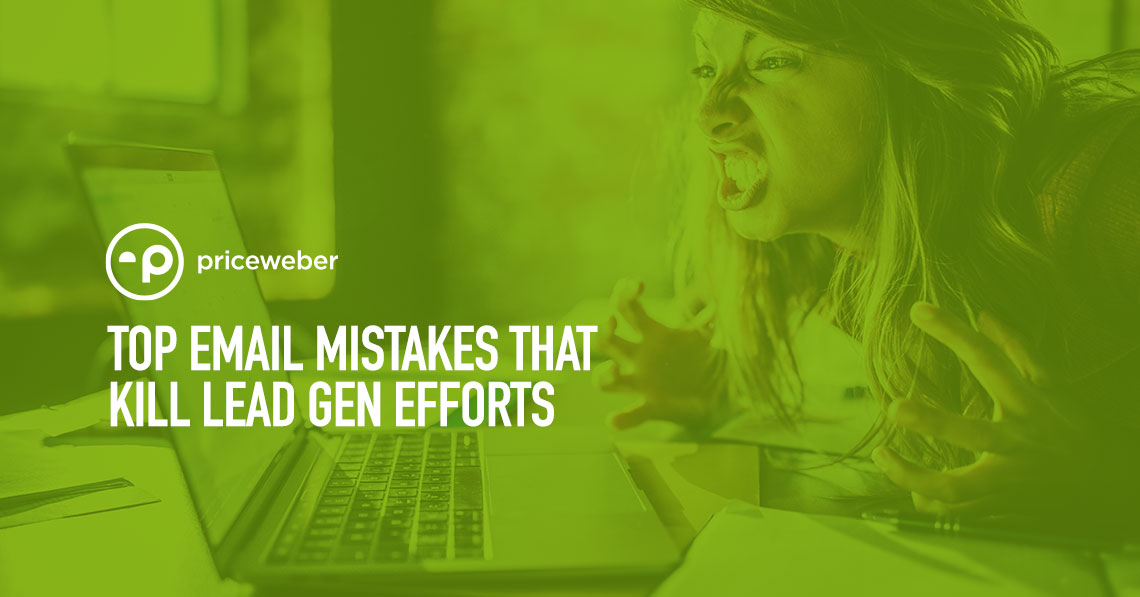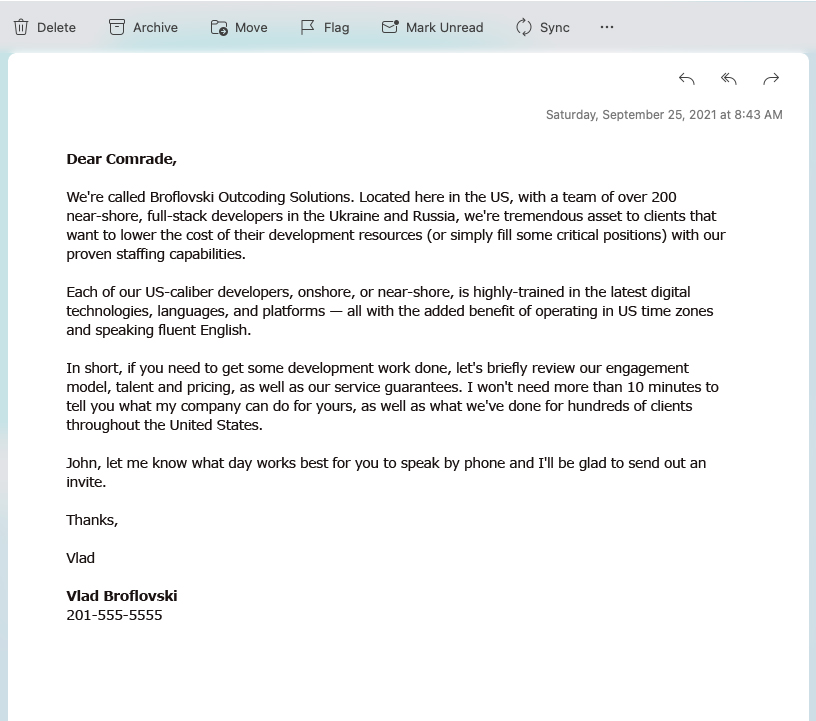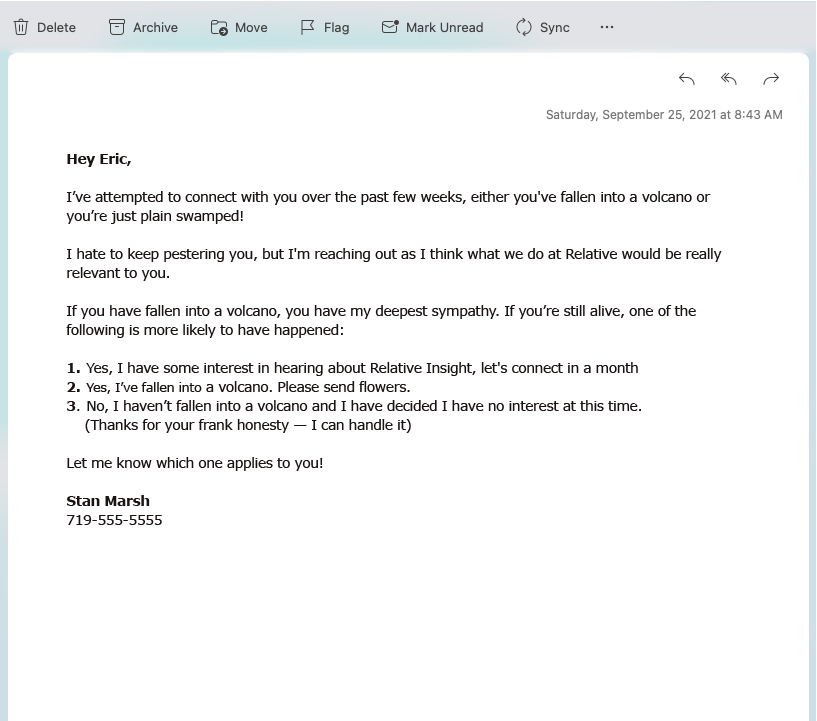There’s no question that maximizing your email marketing as part of a robust performance marketing program is one of the smartest and most cost-effective things you can do to help boost your marketing horsepower. In fact, we’ve got a great article stuffed with tips for high ROI email campaigns if you’d like to check it out. However, in today’s Plain Talk, our article assumes you already know how critical email marketing can be, so we delve right into what you should say and what you shouldn’t say in your emails if you are looking for meaningful long-term success.
Email Marketing Mistakes to Avoid:
In some ways, we hope this article will be a little cathartic because it will address some of the emails that regularly pollute YOUR inbox. We’ve broken down some of the worst email blunders here:
1. The Hustle – This email marketing mistake is the straight sell email. You know it – “Hi, I have a product or service that I just know will transform your business, so hit me back or click the link below to set up an appointment so I can solicit you!” Okay, they may not say exactly that, but definitely something like it! This is the email from a perfect stranger. They have exhibited no real knowledge about your business and yet they are essentially telling you that you are doing it wrong. The nerve! The logical customer’s reaction here is to either hit “delete” or “junk” and get on with their lives. Like a broken clock that’s only right twice a day, you may get an occasional response, but not for the right reasons.
2. Open Mouth, Insert Foot – This email marketing blunder often happens when marketers are using email lists that are poorly vetted or when a marketer simply does not do their homework. It goes something like, “Hi prospect, we are in the widget business and want to sell you some of our premium widgets!” Innocuous enough, but when you consider that you too are in the premium widget business, the email suddenly becomes pretty frustrating. Delete.
3. The Bully – We get it that there may be times in an email campaign where a marketer may see value in speaking to a director or decision-maker and possibly to his or her boss or CEO. But some email bullies have adopted the practice of emailing the supposed decision-maker and cc’ing his or her CEO as a way to force a response or to try to go over the decision-maker’s head. Not only is this super sleazy, but we promise, you WILL make an enemy of the decision-maker. Delete. If marketers feel it’s critical to communicate to all levels of a department, send each person his or her own email.
4. The Form Complete Recruiting Play – Now, the marketer is getting creative, or at least they think they are. Rather than emailing the correct contact with a compelling story, you may find a marketer completing an online form on your website to try and break through or bypass your internal procedures. On most occasions, a website form completion is fine, and is not in itself an email marketing mistake. That’s what they are there for, right? But this rascal isn’t just competing your vendor form. Nope, they are filling out your career inquiry form, your new customer form, your customer complaint form, etc. In fact, if you have a form, they are completing it. Why? The misconception is that it’s okay to interrupt HR’s day to get them to forward your message to the right person. It’s not. In fact, it’s really rude. Delete.
5. A Quick Chat – This email marketing mistake is easy to cover off. It’s the innocuous email requesting a “quick chat.” It goes something like, “Hey person, I’m Jack from Company X and I think we should schedule a quick chat to talk about something I think you need.” This is a lot like “The Hustle,” but even “The Hustle” has a somewhat defined reason for the call. The “quick chat” person is counting on the mystery and intrigue of his or her lack of specificity to help draw you in like a fly to a spiderweb. But here’s the thing…today there is no such thing as a quick chat. If anything, people today are wrestling with being significantly overscheduledand stressed out. In fact, an alarming number of workers are so worried about their productivity that they are skipping meals. So, not only do marketer’s emails need to be more important than regular work to get that quick chat, sometimes they need to be more important than food!
6. Swing and Miss – Sincerity is one of those things we all hope to express when we make an impression with a prospect by email. That’s why the “Swing and Miss” email is such a bad idea. This email goes something like, “Hey person, looks like I may have missed you with my last email so I’m reaching out again for the same reason I emailed you last time.” Here’s the thing – this marketer didn’t ring your doorbell. It’s not 1994 and they are not leaving a message on your answering machine. They sent you an email. You either got it or it ended up in your spam filters so the “Whoops, we must have missed each other” approach ends up feeling hollow and insincere. Not a great impression. Delete.
7. A Volcano? – Special mention goes to a few recent emails where people have asked if we had fallen into a volcano, contracted amnesia, or had been attacked by sharks (or fill in disaster here). After a brief moment of bewilderment (wait, what?) the end result is that “No, we did not fall into a volcano.” Rather, the marketer’s email just failed to offer us a reason to care enough to respond. This is just a silly version of the “Swing and Miss,” and while we all appreciate a little humor, the underlying problem persists – that the marketer’s email lacks substance.
8. The Fake Friend – This is another email marketing mistake that appears to deliberately mislead the reader. When you’re done reading this email, you have to pause and think about whether you know the sender based on their wording and overly casual tone. Maybe it’s someone you once met at your second cousin’s wedding? Surely a perfect stranger wouldn’t be obnoxious enough to act as though they’re your best friend, but in reality, nope, you don’t know them. The lack of authenticity this approach represents is likely to blow up in the sender’s face. Delete.
9. The Bump – Finally, let’s take a moment to acknowledge what may be the worst of all email “touches” in a marketer’s campaign. Let’s assume some marketer out there committed any one of the aforementioned email atrocities. You’ve accordingly hit “delete” and have politely gotten on with your life. Then, one morning you get an email that says, “Hey person, I know you’re busy, so I wanted to bump this up in your email queue to make sure you don’t miss out on this life-altering thing I’m selling!” That’s right, “The Bump.” The very best way to ensure that you have annoyed your prospective client not once, but twice. That’s one time too many. The bump as a most reviled practice isn’t even NEW! In fact, in 2019, Glassdoorreleased a list of email jargon that was most hated and guess what was at the top? Delete.
Do You DESERVE To Be Read?
Okay, so we’ve seen some common gaffes in email copy strategy. Maybe you’ve experienced one or two yourself. But even outside of these extremes in bad practice, many marketers are not asking themselves the single most important question about their email before sending it – “Do I deserve to be read?” What, if anything, are you doing for a prospective reader that leads you to believe that you are worthy of three to five precious minutes of their time? And we have to tell you, today it had better be good because while three quarters of people list email as their preferred communication method at work, exactly zero percent like to have their time wasted. So, to finish on a positive and useful note, here are three ways to earn the right to be read by your prospect:
1. Discounts, Incentives, Trials and Free Samples – An approach that is truly timeless – show up bearing gifts. It could be dollars off a first purchase, a free sample or a 30-day software trial, but if you lead with an intriguing offer of something that has the right amount of value, you may find much higher audience participation. For example, in a recent email survey of doctors and patients where we asked some simple questions, we found that patients were very open to answering the survey for a $25 Amazon card, while for doctors, the price went to $250 each. (It’s worth remembering that “value” may not mean the same thing to everyone.)
2. Offer Knowledge – Another way to earn the attention of your target is to lay some knowledge on them. This could be something like a white paper, research or an article that will be useful to help your audience solve a typical problem they might normally have. You’ll be surprised how many doors this will open.
3. Offer a Consultation – A variation of one and two, the consultation method is much more targeted to the individual prospect and gives them insight into your approach to help them solve a very specific problem that they have. This is ideal for an account-based marketing (ABM) approach, and accordingly, will require more effort and less scale; however, this approach can get you a seat at the table with decision-makers faster than most approaches, AND gives you the opportunity to gain insights into your prospect’s business while striking up relationships.
But you may say, “Some of these things sound like a lot of work,” or there might be some expense you hadn’t thought of. This brings us to a reality and a bit of a misconception about email marketing in general – the idea that email marketing is kind of a way to cheat – a way to avoid all of that branding and advertising stuff. For more on this, check out Mary Kate Reed’s article on Branding vs Performance Marketing, but note the more effort you invest to build your brand (trust, reputation, quality, etc.), the less effort you will need to put into convincing your audience that you deserve talking to. Brands that choose to invest only in direct marketing (like email) without building their brand, will find that these approaches may be necessary in order to “deserve” to be read.
Hopefully this article offered you a fun glimpse into best practices that you can apply to your email marketing campaigns. If you find yourself in need of integrating that email campaign into bigger and better performance marketing efforts, or just want to share your most recent awful email (we collect them), please call us at 502-499-4209, or drop us a note, and we’ll get right back to you. You won’t even have to bump anything to the top of our email list!




